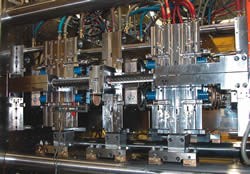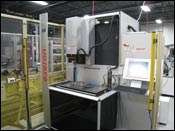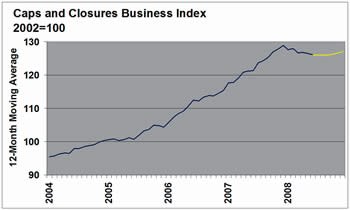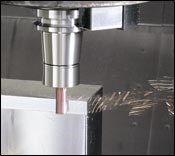Complex Molds Mean Business for High-Tech Toolmakers
Focus on cavitation and advanced product design gives progressive mold shops a jump on competitors.
Moldmakers are adapting their design and fabrication capabilities to meet sharper requirements for injection molds in consumer products. The requirements stem from influences on product development in several areas: manufacturing economics, green design and quality.
Since most consumer products are commodities, OEMs look to productivity to improve margins. This often means higher cavitation in single-face tools and stack molds. Husky Injection Molding Systems Ltd. (Bolton, ON), for example, built a custom hot runner system for a single-face medical closures mold with 192 cavities. Stack-mold specialist StackTeck (Brampton, ON) reports growing interest in 2- and 3-level molds from OEMs running single-face tools, and in 3- and 4-level versions from those with 2-level molds. Many of StackTeck’s high-cavitation molds, moreover, use the company’s proprietary quick-product-change features for lean manufacturing.
Demand for eco-friendly design is commonly addressed with thinner-wall parts and components, a solution with synergistic benefits for OEMs: waste reduction in product disposal—a plus at retail—and lower material costs, a critical issue with the ongoing run-up in resin prices.
While product quality is a given, high-volume production and downgauging challenge mold design. One issue is the effect that higher injection pressures needed for thinwall parts have on hot runner systems and their ability to evenly distribute resin. Coupled with this are ejection mechanisms that can demold thinwall parts without deforming them. Mold tolerances are also a concern. Thin parts and fast cycles increase the need for precise tolerances and alignment of moving parts.
Automation Is Key to Growth
Mold shops are responding with technologies and components to meet these needs. One important area is automation. A growing number of moldmakers are automating fabrication processes on a large scale, and in the process reducing mold building costs, improving quality and shortening leadtimes.
There also is an effort to consolidate mold components and minimize moving parts. This is done with advanced milling and EDM systems that machine mold shapes in place of inserts. Experts say advances in speeder heads, for instance, yield spindle speeds of 150,000 rpm, which permit small, highly precise shapes to be cut into molds. High speed also increases feedrates.
Suppliers and moldmakers, meanwhile, are developing components that improve part ejection and simplify the design and fabrication of complex tools.
Taken together, these developments improve the productivity and profitability of moldmakers and—and significantly—enhance their competitiveness against offshore rivals. So much so that some experts claim North American mold shops are seeing a significant increase in business this year despite the U.S. economic slump.
“This has been one of our busiest years,” says Joe Hollenbeck, President of Integrity Mold Inc. (Gardner, MA). Hollenbeck attributes some gains to business that returned from China because of quality problems. But Integrity also installed an automated moldmaking cell in March that improved production capabilities 30 to 40 percent, reduced leadtimes with 24/7 “lights out” operation and cut manufacturing costs. Hollenbeck expects to recoup the $1-million investment in four years.
Market Data
High resins prices and slow economic growth have inhibited the expansion in U.S. market demand for injection molded caps and closures so far in 2008. Total output will hold steady at current levels through the rest of this year, and a gradual trend upward will resume in 2009. Data Source: Federal Reserve Board. Forecast: Mountaintop Economics & Research, Inc.
The mold cell, developed by distributor Methods Machine Tools Inc. (Sudbury, MA), includes a die sinker from Exeron (Oberndorf, Germany; distributed by Methods) and a TrodeMaster RoboDrill milling machine, RoboCut wire EDM and track robot from Fanuc (Rochester Hills, MI).
The cell has three workstations aligned along the robot’s track. Workpieces are palletized for automated selection. A unique feature is the ability of the RoboDrill unit to machine as many as 200 electrodes for the die sinker in one operation. “We can make them for different jobs,” adds Hollenbeck. “We don’t have to do 200 for one job.”
Key to the operation is software developed by Hirschmann Automation and Control (Chambersburg, PA). “This runs everything,” says Stephen L. Bond, National Sales Manager at Methods. Each electrode and pallet has ID chips that the robot reads. The software manages the work schedule and determines which projects the robot selects for each workstation, and prioritizes the job for each machine.
Hollenbeck originally planned to add three conventional machining systems to his shop, but that would mean hiring three to four workers, a major expense. He scribbled his idea for an automated cell on a piece of paper, took it to Methods and both companies worked for a year to finalize the design and equipment.
“The cell keeps our man-time down, which keeps costs down and makes us pretty competitive,” says Hollenbeck. “The only thing I can control is my man-time. If I control that, I get savings.”
Thinking Ahead Pays Off
Integrity’s success with the automated cell comes as no surprise to Dale Mickelson, President of DM Consulting (Hanover Park, IL), which specializes in high-speed machining and hardmilling. Moldmakers who embrace automation see major returns, he notes.
“Five to seven years ago there were a few moldmakers who knew they had to use automation to get ahead of the curve,” Mickelson says. “The guys who did are the ones winning the contracts today. If you want to be competitive, you have to do this.”
Mickelson, who works with mold shops on automation systems, says automating various operations makes a big difference in efficiency and yields substantial savings.
One area is inspection, where an automated system analyzes a tool and makes sure the tolerances are right before it’s removed from machining. This eliminates the time spent in pulling a mold on and off a machine until the tolerances are exact. It also lets a moldmaker check cutting effectiveness. “When a tool wears out, he immediately sees it in the mold geometry and can rerun the piece with a new tool,” Mickelson says.
Another area is pallet automation. “We can put multiple cavities on pallets and let them run overnight with lights out,” he says. This reduces setup time because an automated system machines different cavities without operator insertion and removal of each one. Mickelson estimates that a mold shop can shorten setup time at least 50 percent this way.
An automated pallet system also is a boon to lean manufacturing, he remarks, since it lets customers order—and moldmakers fabricate—only what’s needed.
Automation gets a boost from devices that are engineered to maximize its benefits. One example is tooling and spindles from Big Kaiser Precision Tooling Inc. (Elk Grove Village, IL). The company’s Big-Plus spindle is designed to improve the rigidity and accuracy of tools during automated changeover, and ultimately, increase spindle speed over conventional interfaces.
This is a result of what Big Kaiser calls dual-contact tooling. “When the tool goes into the spindle it doesn’t just locate on the taper but on a face surface, which increases its rigidity and the accuracy of the tool change,” says Jack Burley, Vice President of Engineering and Sales.
Dual-contact tooling also eliminates centrifugal force and heat expansion, he claims. Machines can do high-speed cutting, accommodate high-speed feeds and improve process reliability, Burley adds. Big Kaiser guarantees that tools will hold a cutter-to-spindle run-out of less than 3 microns. Burley says the industry average is around 10 microns.
As an example of the speeds that can be reached, a 30-taper Big-Plus spindle runs at 40,000 rpm, a 40-taper spindle at 30,000 rpm, and a 50-taper spindle at 22,000 rpm.
“Complex and high-tolerance molds require toolmakers to have a keen awareness of better-productivity tools that have tighter tolerances, hold tighter tolerances and maintain cutter life longer,” Burley says.
Big Kaiser will formally introduce a cutter for deburring at IMTS this month that provides similar advantages. Called C-Cutter Mini, it is less than 5/8th-inch in diameter, has four flutes instead of one as on most deburring tools, is balanced, indexable and runs at 20,000 rpm. Four flutes make the feed rate four times faster than single-flute tools. Chamfering time can be reduced to as little as 20 to 30 minutes from an average 2 to 3 hours with conventional tools, Burley says.
Cavitation Affects Design Complexity
Balancing increased resin flow in high-cavitation tools is a challenge for hot runner suppliers. “If someone had asked a few years ago if we would build a 192-valve gate, I would have said no,” remarks Martin Baumann, Business Development and Marketing Manager at Husky.
But as technology progressed, Husky did build a custom hot runner system for the closures mold. Baumann notes, however, that a mold that size requires far more injection pressure than usual, which puts a strain on hot runner systems, especially when thinwall parts are involved. “Pitch spacing or gate access requirements are still the same despite higher cavitation, so you can’t just make nozzles bigger,” he says.
Husky has developed hot runners that withstand 35,000-40,000 psi without cracking nozzles or manifolds. Baumann says the developments involve innovative designs in combination with new materials, as well as manifold design, which assures an even balance of resin flow in high-cavitation molds. Though the 192-drop hot runner was a custom system, Husky has expanded its standard Pronto hot runner up to 96 drops from its original configuration of 2 to 8 drops.
Work also is underway to fine-tune component design for high-cavitation molds. One growing need with flip-top caps is closing them prior to demolding to improve handling. Most molds do this with two vertical rows of cores that create motion from the left and right sides of the mold. Jordan Robertson, General Sales Manager at StackTeck, says placing the cores this way limits cavitation. Stack-Teck has an in-mold closing and ejection system that optimizes the allocation of space for cavities and the closure mechanism in single-face and stack molds, so the full platen area of the machine can be utilized.
Robertson declines to reveal details about the design for competitive reasons, but says the mold-closing mechanism is integral to the mold and positioned between the rows of cavities. “We have built up to 32 cavities per face with this design, and it’s an approach that can be easily expanded to any cavitation need.”
Components Upgrade Mold Design
Another ejection system that is claimed to be efficient, as well as capable of reducing mold building costs and improving cycle times, is Quick Strip from D-M-E Co. (Madison Heights, MI), which was introduced in North America in August.
The three-part system comprises a vertical base, sliding vertical riser and a horizontal strip 10mm. thick connected to the riser. Quick Strips are positioned on either side of a cavity, with the horizontal strips nesting under the edges of a part. The device is actuated by the mold-opening sequence. This causes the risers to slide up, raising the horizontal strips and lifting the part from the cavity. Each riser has a tapered section that causes the strip to tilt slightly away from the part at the end of the stroke. This frees the part from the strips, completing the ejection cycle. The risers retract and the strips revert to either side of the cavity.
The strips can be machined to match part geometry and inserted in a mold as cavities and cores are cut, says Chuck Azzopardi, Global Business Manager for Mold Bases and Components. Strip blanks come in three sizes.
Quick Strip eliminates conventional ejector plates and pins, risers and clamping plates, and the machining they require, thus saving on fabrication cost. It will reduce mold height and free up space for an improved mold cooling system. Eliminating the ejector stroke can speed mold cycle time, and there will be no marks on products from ejector pins. Azzopardi says that by reducing tool size, Quick Strip may permit some molds to run on smaller presses.
In another area, collapsible cores, Progressive Components (Wauconda, IL) has added five standard sizes to its line of pre-engineered C-Cores, which are designed for threaded parts. Three of the sizes are smaller than the original sizes and two are larger. They include: CC-125-PC (0.72-inch); CC-150-PC (0.85-inch); CC-175-PC (0.97-inch); CC-652-PC (3.80-inch); and CC-701-PC (4.225-inch).
The cores are engineered to simplify mold design, tighten cavity spacing, which can reduce mold size, and cut cycle times by up to one-third through elimination of a gear/rack activation device. Progressive also reports that making the sizes standard reduces delivery times.
Summary
Consumer product OEMs want molds that meet daunting standards of quality and productivity. Moldmakers who adapt their operations and cost structures to surmount the challenges these molds pose, will be rewarded with increased business.
Related Content
It Starts With the Part: A Plastic Part Checklist Ensures Good Mold Design
All successful mold build projects start with examining the part to be molded to ensure it is moldable and will meet the customers' production objectives.
Read MoreTips for Tackling Mold Design, Machining, Cutting Tool and Wear Challenges
Tips for tasks ranging from reducing risk in part design and taking advantage of five-axis machining to refining cutting tool performance and reducing wear with guiding and centering systems.
Read MoreWhat Is Scientific Maintenance? Part 1
Part one of this three-part series explains how to create a scientific maintenance plan based on a toolroom’s current data collection and usage.
Read MoreHow a Small Programming Change Cuts Cycle Time in Half
Overriding the CAM system when milling a series of lifter pockets helps to improve metal removal rate and increase feed rates.
Read MoreRead Next
How to Use Continuing Education to Remain Competitive in Moldmaking
Continued training helps moldmakers make tooling decisions and properly use the latest cutting tool to efficiently machine high-quality molds.
Read MoreAre You a Moldmaker Considering 3D Printing? Consider the 3D Printing Workshop at NPE2024
Presentations will cover 3D printing for mold tooling, material innovation, product development, bridge production and full-scale, high-volume additive manufacturing.
Read More


























